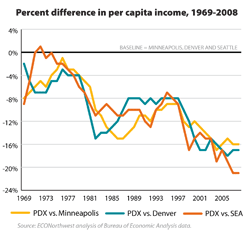What the Numbers Show
Portland-metro vs. peer metros
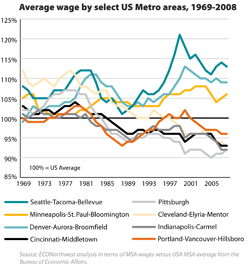 This study compares Portland-metro to three other major
metropolitan areas: Seattle, Denver and Minneapolis. These
three regions were selected because they frequently serve as
benchmarks for Portland-metro on a variety of metrics. In the
early 1970s, Portlandís per capita income compared favorably
to these peer regions. Today, we look markedly different. There
is no one reason that fully explains the differences between the
economies of Portland-metro and our peers; however, the
following analysis paints a picture of the relative strengths of
the four economic regions.
This study compares Portland-metro to three other major
metropolitan areas: Seattle, Denver and Minneapolis. These
three regions were selected because they frequently serve as
benchmarks for Portland-metro on a variety of metrics. In the
early 1970s, Portlandís per capita income compared favorably
to these peer regions. Today, we look markedly different. There
is no one reason that fully explains the differences between the
economies of Portland-metro and our peers; however, the
following analysis paints a picture of the relative strengths of
the four economic regions.
Wages
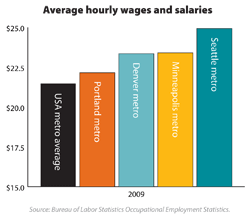 The ECONorthwest analysis shows that in the early 1970s
Portland-metroís wages were similar to those in Seattle, Denver
and Minneapolis metros. But since then the metro areas have
diverged on average wages. Today Portland-metro wages are 6
percent above the national average for all metropolitan areas
but Denver and Minneapolis metro wages are 12 percent above
the national average and Seattle is 19 percent above. Currently,
Portland-metro wages are more like Cleveland, Pittsburgh and
Indianapolis metros than they are like Seattle, Denver, or
Minneapolis metros.
The ECONorthwest analysis shows that in the early 1970s
Portland-metroís wages were similar to those in Seattle, Denver
and Minneapolis metros. But since then the metro areas have
diverged on average wages. Today Portland-metro wages are 6
percent above the national average for all metropolitan areas
but Denver and Minneapolis metro wages are 12 percent above
the national average and Seattle is 19 percent above. Currently,
Portland-metro wages are more like Cleveland, Pittsburgh and
Indianapolis metros than they are like Seattle, Denver, or
Minneapolis metros.
Why compare Portland-metro to these other metro areas?
Seattle, Denver and Minneapolis are common cities for Portland to benchmark against for livability, transportation systems and economic development. All of the cities have exchanged ďbest practicesĒ visits with Portland for benchmarking purposes. Our falling incomes now makes us more like PIttsburgh or Cleveland, as illustrated in the graph above.

Per Capita Income
Since the 1970s, Portland-metroís per capita income has been declining relative to peers and the gap as accelerated since the mid-1990s. Portland-metro is now 21 percent behind Seattlemetro on per capita income, a $10,000 per year difference. Per capita income in Denver and Minneapolis-metros are both more than 16 percent higher than Portland-metro.
Investment Income
Wages are an important component of per capita income. But investment income is also a significant source of income, including taxable income that supports public services. Portland-metro residents reported 9 percent less per capita investment income than Denver-metro residents, 15 percent less than Minneapolis-metro residents and 25 percent less than Seattle-metro residents. Had investment income kept pace with Seattle-metro over the last 10 years, total personal income in Portland-metro would have been nearly $6.4 billion higher in 2008. Investment income is important not only for providing more resources for public services, but also for seed money for start-ups and other entrepreneurial activity, which spurs more economic growth.
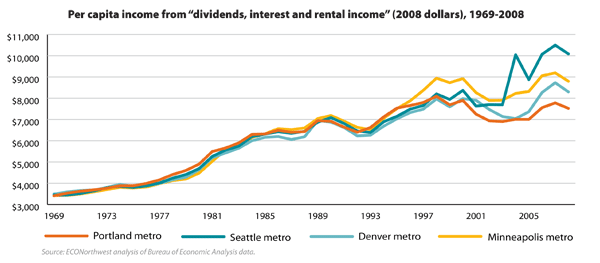
Why compare Portland-metro to these other metro areas?
This graph shows that Portland-metro per capita income from investments started almost equal to that of our peer metros, but stalled in 1994, and now lags significantly behind them.

Affordability
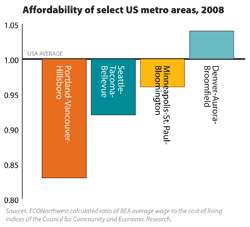
This graph shows that Denver has higher wages and lower costs. So, comparitively, Denver residents have the greatest buying power and Portlandís the least.  |
Portland-metroís cost of living is lower than Seattle-metroís and, indeed, is lower than any other major west coast metroarea. However cost of living tells only part of the story because it doesnít take our relatively low wages into consideration. When wages are considered, Portland-metro is less affordable than Seattle, Denver or Minneapolis. The reason is that our wages are lower relative to housing and other costs than in our peer cities. Improving wages while keeping housing costs stable would significantly improve the affordability of our region.
Quality of Life
The Portland region continues to command a high quality of life that helps to attract young, skilled workers and potentially somewhat compensates for the regionís lower wages and income. However quality of life is not enough. Other communities have also increasingly focused on improving their quality of life while, at the same time, providing higher wages and income. Communities such as Denver and Seattle-metro have achieved both higher incomes and higher quality of life than Portland-metro.* The link between wages, income and quality of life is significant. If we have lower incomes than our peers we will also have fewer public dollars to provide services such as quality schools, parks and social safety nets.
* David Albouy, Working Paper 14472, National Bureau of Economic Research
Traded Sector
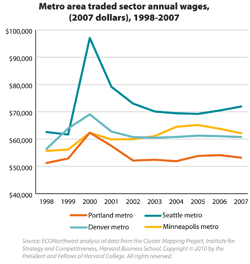 Traded-sector firms are those that sell goods or services
outside the local geographic area. The state and regional
economies benefit tremendously from the existence of tradedsector
firms that bring additional income into the community,
which tend to raise the standard of living for all residents. The
Portland-metro economy has a number of strong traded-sector
industries with clear prospects for growth.* While our tradedsector
jobs pay better-than-average wages for the region,
Portland-metro traded-sector wages still lag significantly
behind the traded-sector wages of our peers, and the regionís
share of payroll from the traded sector is declining.
Traded-sector firms are those that sell goods or services
outside the local geographic area. The state and regional
economies benefit tremendously from the existence of tradedsector
firms that bring additional income into the community,
which tend to raise the standard of living for all residents. The
Portland-metro economy has a number of strong traded-sector
industries with clear prospects for growth.* While our tradedsector
jobs pay better-than-average wages for the region,
Portland-metro traded-sector wages still lag significantly
behind the traded-sector wages of our peers, and the regionís
share of payroll from the traded sector is declining.
* See 2008 Greater Portland Prosperity; A Regional Outlook, Greenlight Greater Portland.
Employment
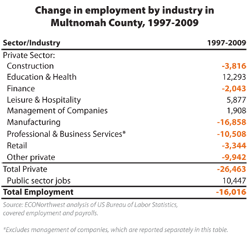 Multnomah County, Portland-metroís urban center, has
suffered from a long-term loss of jobs that began well before
the current economic downturn. Ranking the 194 counties and
five multi-county areas in five western states, Multnomah
County is second from the bottom in job creation from 1997
to 2009, having lost more than 26,000 private-sector jobs
during that period. (King County, which includes Bellevue and
Redmond, added nearly 68,000 jobs in the same time period.)
While Multnomah County saw an increase of 10,000 publicsector
jobs over that same period, the erosion of private-sector
employment in the regionís largest economic center is not
sustainable. Significantly, high-wage, high-skill jobs in the
manufacturing sector, as well as professional-sector jobs that
support other businesses, accounted for most of the job losses
in Multnomah County. The loss of professional-sector jobs can
be linked to a long-term loss of large headquarter companies
in Portland-metro.
Multnomah County, Portland-metroís urban center, has
suffered from a long-term loss of jobs that began well before
the current economic downturn. Ranking the 194 counties and
five multi-county areas in five western states, Multnomah
County is second from the bottom in job creation from 1997
to 2009, having lost more than 26,000 private-sector jobs
during that period. (King County, which includes Bellevue and
Redmond, added nearly 68,000 jobs in the same time period.)
While Multnomah County saw an increase of 10,000 publicsector
jobs over that same period, the erosion of private-sector
employment in the regionís largest economic center is not
sustainable. Significantly, high-wage, high-skill jobs in the
manufacturing sector, as well as professional-sector jobs that
support other businesses, accounted for most of the job losses
in Multnomah County. The loss of professional-sector jobs can
be linked to a long-term loss of large headquarter companies
in Portland-metro.
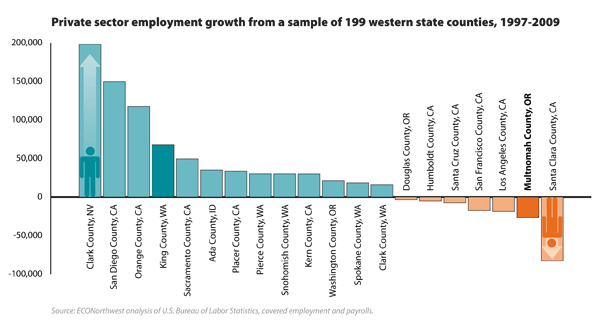
Santa Clara County, CA, home to Silicon Valley, lost tens of thousands of jobs in the high tech bust beginning in 2008. In graph above multiple counties are not graphed due to space limitations. To see full list of counties, read full report at www.valueofjobs.com.

Education
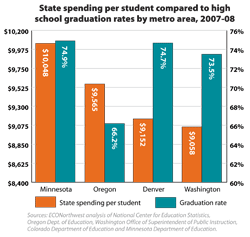 Oregonís four-year high school graduation rates fall well below
those of Washington, Colorado and Minnesota according to
the National Center for Education Statistics. At the same time,
Oregon spends more per student than both Colorado and
Washington (although still less than the national average),
while achieving poorer graduation rates. Minnesota spent the
most of the four states, but they also achieved a very high
graduation rate. Beyond high school, Oregon ranks 44th
among the 50 states on college affordability, while Colorado,
Minnesota and Washington rank 25th, 32nd and 34th,
respectively. A strong, efficient education system is particularly
important for producing a workforce for the higher-wage,
knowledge-based industries that help drive the higher incomes
in our peer regions.
Oregonís four-year high school graduation rates fall well below
those of Washington, Colorado and Minnesota according to
the National Center for Education Statistics. At the same time,
Oregon spends more per student than both Colorado and
Washington (although still less than the national average),
while achieving poorer graduation rates. Minnesota spent the
most of the four states, but they also achieved a very high
graduation rate. Beyond high school, Oregon ranks 44th
among the 50 states on college affordability, while Colorado,
Minnesota and Washington rank 25th, 32nd and 34th,
respectively. A strong, efficient education system is particularly
important for producing a workforce for the higher-wage,
knowledge-based industries that help drive the higher incomes
in our peer regions.
Economic strengths
International Trade
International trade is a bright spot in the regional economy. A recent national study by the Brookings Institution finds that Portland is one of the most trade-dependent communities in the country, and our economy benefits tremendously from international trade. Eighty-eight percent of Oregonís exporting companies were small and medium enterprises as of 2008. Exports boost wages as well. Studies show workers at exporting firms earn wages 9 to 18 percent above those wages for workers at non-exporting firms.*
* These findings are from an analysis of international trade in Oregon and the Portland-metro region commissioned by the partners in this study.
Small Business
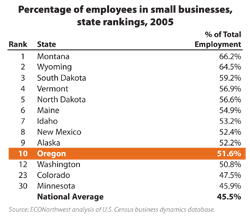 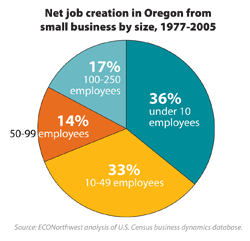
|
Oregon has a vibrant small business sector with more than half the stateís workers employed by small businesses. Businesses that have fewer than 250 employees accounted for 66 percent of the net job creation in Oregon between 1977 and 2005. Small businesses, however, have lower wages and benefits, on average, than large businesses. While Oregon has a strong small business presence in international trade and the traded sector, these businesses nevertheless rely to a great degree on the presence of large national and international traded-sector firms for their success. A successful job-creation strategy must seek to retain and grow both small businesses and larger businesses to ensure long-term economic stability.









 What the numbers show
What the numbers show
